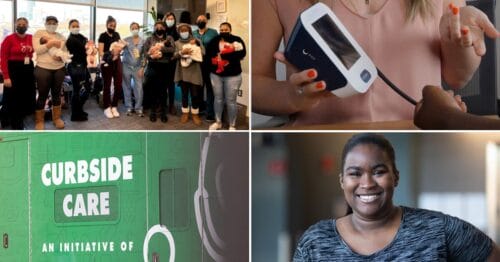Autism Disparities and Racism: An Interview with Sarabeth Broder-Fingert, MD, MPH
August 26, 2020
By Meryl Bailey

Getty Images
The researcher issues an urgent call to action to help end critical delays in the diagnosis of autism spectrum disorder in children of color stemming from structural racism and implicit bias.
New research reports significant delays in the diagnosis of Black children with autism spectrum disorder (ASD). Published in Pediatrics, the study cites an average three-year lag between the first parental concern over developmental delay and an ASD diagnosis for African American children. The findings add to mounting literature highlighting stark racial disparities in the diagnosis and treatment of autism, a disorder for which early diagnosis and intervention are essential for improving long-term outcomes.
The process of getting an autism diagnosis is complicated. A child’s assessment generally requires two to four visits with a diagnostic team, spread out by a couple of weeks or a month each. Due to the limited capacity of providers who are qualified to make a diagnosis, the waitlists for assessment tend to be long, further drawing out what is already a lengthy process. However, families with greater resources may be able to skirt the issue, paying thousands of dollars out of pocket for a private assessment on an expedited timeline.
Although deeply troubling, the new evidence of a racial divide in timely diagnostic assessment doesn’t surprise Sarabeth Broder-Fingert, MD, MPH, a pediatrician at Boston Medical Center and principal investigator at the Boston University School of Medicine’s Autism Disparities and Innovations Lab. Familiar with the many obstacles that nonwhite communities face in the Boston area, she believes that the medical community must address the systemic racism that causes Black and Latinx children to wait years for autism diagnosis and treatment. Her commentary responding to the new study, published in the same issue of Pediatrics, identifies likely drivers of the disparity and offers actionable steps to address them.
Policy reforms raising low Medicaid reimbursement rates for autism assessment and a greater capacity and broader diversity in the workforce could drastically improve access to timely care for underserved communities, argues Broder-Fingert. Coupled with increased participant diversity in efforts to refine autism screening tools, an investment in cultural competency training for current healthcare providers could also reduce implicit bias that leads to treatment delays.
Broder-Fingert recently spoke with HealthCity about how structural racism impacts ASD assessment and immediate actions the medical community can take to address inequities.
HealthCity: Researchers often use words like barriers and disparities when describing inequities in health services. Why did you title your commentary “Structural Racism and Autism”?
Sarabeth Broder-Fingert, MD, MPH: The word “racism” is not used enough in the field. It’s a really important problem, and people often shy away from actually saying it. With a lot of these systems issues, people tend to talk about them as “barriers” or “disparities,” but in many instances, the underlying root cause is racism. We wanted to make that clear: Yes, there are a lot of challenges that families face, especially families of color, but when you pull them apart and look at things like the challenge of getting to an appointment from far away, that’s actually rooted in racism. Or take barriers to trusting the healthcare system: It’s not as though you were born not trusting the healthcare system—your experience of racism led to your lack of trust.
HC: How has systemic racism manifested in the medical system to create racial disparities in autism assessment and treatment?
SB-F: Many structures are in place that make it harder for minority populations to access healthcare and medical and educational services. There are geographic issues. If you want to go back in time, redlining and other discrimination led to nonwhite families living in certain parts of the country that tend to be lower-resourced. Not only does that lead to challenges in accessing special education, but those areas might have a limited workforce to perform the diagnostic assessment and provide treatment. So, structurally, there’s just a lot less capacity to diagnose these kids. The reasons for that are related to the systems currently in place. For example, the Medicaid reimbursement for autism diagnostic evaluation is significantly lower than what private insurance might pay.
There’s also stigma and bias when it comes to actually accessing medical services. Who’s going to get their child assessed somewhere where they don’t feel comfortable or welcome?
HC: What must researchers consider so they don’t reinforce or perpetuate systemic racism?
SB-F: Researchers like to point fingers at someone else as to why disparities exist. But I do think we also have to point our fingers at ourselves. One of the biggest concerns for me is that traditional autism research has been performed on white, higher-income children and families. That means any diagnostic test or any screening tool to detect risk that’s been validated — even treatment that has been tested in the field — may have inherent biases in them because they’ve only been tested on a relatively narrow population of kids.
We have to have in mind, who are the real people that are going to use this tool? And if we can’t get any of them to participate in our study because it’s too much work for them, then the treatment we’re developing is just not good.
HC: Your commentary spotlights that only 2% of autism providers are Black, a stat that is especially troubling coupled with the knowledge that a care team resembling the patient population is important for building trust. What can be done to bring diversity to the ASD workforce?
SB-F: We should absolutely be doing more to recruit and retain Black and Latinx psychiatrists, psychologists, developmental pediatricians, and neurologists. These are the categories of professionals that can currently diagnose autism. But there is also another approach that we need to pursue more aggressively.
We are actively trying to lobby to say the stringent guidelines on who is allowed to diagnose autism need to be relaxed, from an equity standpoint. The workforce capacity issue is, without a doubt, much more of a problem for children of color and low-income families. If we could expand who we’re allowed to train to diagnose autism, that would be the simplest and most rapid way to increase capacity and also have a greater multilingual workforce who look like the patients that we serve. And the workforce that can be trained to do these diagnostic assessments already exists — physicians, nurse practitioners, physicians’ assistants, and social workers.
So yes, we need to train and recruit more young people into the field, as a whole. But I think there’s also a huge opportunity to expand who can actually diagnose autism, and it’s really important.
HC: With racial inequities front and center of current discussions, what would you say to other providers or researchers who are eager to enter the arena?
SB-F: I appreciate that people are really passionate and feel the urgency of this moment and of the hundreds and hundreds of years of racism in this country. At the same time, when you’re doing studies on race, unless you feel like you really have a sense of the history of racism in this country, you need to find someone who does, who can look at your work and do some quality control. I always encourage investigators to find someone who has that knowledge and expertise. If no one on your team has a good understanding of the construct of race from a societal perspective, then you put yourself at risk of inadvertently doing something harmful.
This interview has been edited and condensed.
Interested in building an autism friendly healthcare practice? Join the first annual Autism Friendly conference, “Building an Autism Friendly Practice,” on September 11, 2020. This conference is designed for healthcare professionals from any discipline or practice setting who want to create or strengthen their organization’s ability to serve patients with autism spectrum disorder (ASD). Click here to register or for more information.


